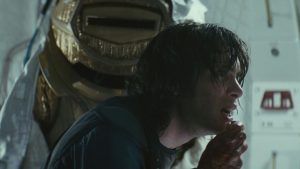Asian cinema has long been a source of groundbreaking and deeply unsettling horror, offering a terrifying alternative to Western genre conventions. While Hollywood was often focused on slashers and jump scares during the genre’s boom in the 1980s and 1990s, filmmakers in Asian countries were cultivating a different kind of fear, rooted in psychological dread, cultural folklore, and the crushing weight of societal pressures. This unique approach created a cinematic movement that produced some of the most artistically daring and emotionally devastating films of the last several decades. That’s because the enduring power of Asian horror lies in its ability to get under the skin and stay there, leaving viewers with a lingering sense of unease that lasts long after the credits roll.
By tapping into universal anxieties surrounding technology, family, and unresolved guilt, Asian horror movies create stories that are both culturally specific and profoundly relatable. The films on this list represent the pinnacle of this tradition, each one an essential and unforgettable journey into the abyss that demonstrates the incredible artistry and terrifying power of Asian horror cinema.
Based on Hideo Yamamoto’s manga series, Takashi Miike’s 2001 film Ichi the Killer is an unapologetic and extreme dive into the world of yakuza violence. The story follows Kakihara (Tadanobu Asano), a sadomasochistic enforcer searching for his missing boss, a journey that puts him on a collision course with Ichi (Nao Omori), a psychologically shattered man who is manipulated into becoming a ruthless assassin. The film is infamous for its graphic and often cartoonish gore, featuring scenes of elaborate torture and dismemberment that are designed to shock and confront the audience. However, Miike’s direction turns the over-the-top violence into a form of surrealist art, creating a cinematic experience that is as stylish as it is stomach-churning.
Beneath the surface-level carnage of Ichi the Killer lies a twisted exploration of pain, pleasure, and obsession. Kakihara is a man driven by a desperate need to experience the ultimate sensation, believing that only Ichi can provide it. As such, the film subverts traditional hero and villain archetypes, presenting a world populated by deeply damaged and morally ambiguous characters. Ichi the Killer is a challenging and often overwhelming film, but its fearless commitment to its own depraved vision and its complex character study make it an unforgettable work of extreme cinema.
Park Chan-wook’s 2009 film Thirst is a brilliant reimagining of the vampire mythos, blending horror, romance, and dark comedy. The film centers on Sang-hyun (Song Kang-ho), a devout Catholic priest who becomes a vampire after a medical experiment goes wrong. Wracked with guilt over his newfound lust for blood, his crisis of faith is further complicated when he begins a passionate affair with Tae-ju (Kim Ok-vin), the neglected wife of his childhood friend. What follows is a tragic descent into moral corruption, as the two lovers are consumed by their intertwined desires for blood and each other.
Inspired by Émile Zola’s novel Thérèse Raquin, Thirst uses vampirism as a powerful metaphor for repressed desire, guilt, and the hypocrisy of religious piety. The film is beautifully shot and masterfully directed, with Chan-wook expertly balancing moments of brutal horror with scenes of unexpected humor and profound sadness. In addition, the performances from Song Kang-ho and Kim Ok-vin are exceptional, capturing the desperate and destructive nature of their characters’ love affair.
Yeon Sang-ho’s Train to Busan revitalized the zombie genre with its high-octane action and surprising emotional depth. The film follows Seok-woo (Gong Yoo), a cynical, workaholic father taking his estranged daughter Su-an (Kim Su-an) to see her mother via a high-speed train from Seoul to Busan. The journey is violently interrupted when a zombie apocalypse breaks out across the country, trapping the passengers in a desperate fight for survival aboard the moving train. The claustrophobic setting becomes a pressure cooker for human drama, as the survivors are forced to confront not only the ravenous undead but also the selfishness and cowardice of their fellow passengers.
While Train to Busan delivers thrilling and expertly choreographed action sequences, its true strength lies in its focus on character development and social commentary. Seok-woo’s transformation from a self-absorbed fund manager into a selfless protector is the emotional core of the story, making the film’s heartbreaking climax all the more powerful. Train to Busan is a gripping and poignant exploration of sacrifice, humanity, and what it means to be a decent person in the face of unimaginable horror, making it an essential Asian horror movie everyone should watch.
The 2004 Thai horror film Shutter is a great example of how to breathe new life into the ghost story. Directed by Banjong Pisanthanakun and Parkpoom Wongpoom, the film follows a photographer named Tun (Ananda Everingham) and his girlfriend Jane (Natthaweeranuch Thongmee) after they are involved in a hit-and-run accident. Soon after, mysterious shadowy figures begin to appear in Tun’s photographs, and he is plagued by severe neck pain. As Jane investigates the strange occurrences, she uncovers a dark secret from Tun’s past, revealing that the haunting is connected to a woman named Natre and a horrifying act of violence.
Shutter excels at building dread, using the concept of spirit photography to create genuinely unsettling and memorable scares. The film also knows how to balance its supernatural elements with a compelling mystery that slowly unravels the truth behind the haunting. Finally, the story’s ultimate reveal is shocking, transforming the film from a simple ghost story into an unforgettable tale of unresolved trauma and inescapable guilt. Its final, chilling image is one of the most iconic in modern horror history, cementing Shutter as a terrifying classic.
Kim Jee-woon’s A Tale of Two Sisters is a beautifully crafted psychological horror film inspired by a Joseon-era folktale. The story follows two sisters, Su-mi (Im Soo-jung) and Su-yeon (Moon Geun-young), as they return home from a psychiatric hospital to live with their father and their cold, cruel stepmother, Eun-joo (Yum Jung-ah). The house is filled with a palpable sense of danger, and the sisters are soon tormented by a series of seemingly supernatural events, all while the tension with their stepmother escalates into violent confrontations.
A Tale of Two Sisters uses its elegant cinematography and unsettling sound design to create a pervasive feeling of unease. The narrative is deliberately fractured and disorienting, mirroring the psychological state of its protagonist and keeping the audience constantly questioning what is real. The true horror of A Tale of Two Sisters is revealed in its devastating final act, which delivers a shocking twist that reframes the entire story as a heartbreaking exploration of grief, trauma, and guilt.
Hideo Nakata’s 1998 masterpiece Ringu is the film that ignited the J-horror boom and introduced Western audiences to a new kind of supernatural terror. Based on the novel by Koji Suzuki, the story centers on an urban legend about a cursed videotape that kills the viewer seven days after they watch it. When journalist Reiko Asakawa (Nanako Matsushima) discovers that her niece was a victim of the curse, she begins an investigation that leads her to watch the tape herself. With her own life now on the line, and her young son also exposed to the curse, Reiko must unravel the mystery of the tape and the vengeful spirit of Sadako Yamamura.
Ringu is the perfect exercise in slow-burn horror, prioritizing psychological tension over jump scares. The film’s power comes from its pervasive sense of inevitability, as the seven-day deadline creates a constant and suffocating feeling of doom. Plus, Nakata’s direction is subtle and restrained, allowing the horror to build gradually until the film’s iconic climax. The image of Sadako crawling from the television is one of the most memorable in horror history, a perfect culmination of the film’s relentless suspense.
Takashi Miike’s Audition is a film that begins as a slow drama and slowly descends into one of the most harrowing experiences in horror cinema. The story follows Aoyama (Ryo Ishibashi), a middle-aged widower who, at the suggestion of his film producer friend, stages a fake casting call to find a new wife. He becomes infatuated with Asami Yamazaki (Eihi Shiina), a quiet and enigmatic former ballerina. As he begins to date her, he ignores several red flags and the warnings of his friend, slowly discovering that Asami’s dark past has shaped her into something truly monstrous.
For its first hour, Audition plays like a character study, lulling the audience into a false sense of security before its infamous final act. The film’s deliberate pacing makes its eventual explosion of violence all the more shocking and effective. The final torture sequence is a work of art, a relentlessly grim ordeal that is impossible to forget. Beyond the shock value, Audition serves as a chilling critique of sexism and objectification, making its horrifying conclusion feel like a twisted form of righteous vengeance.
Which other Asian horror movie do you believe is a must-see for genre fans? Leave a comment below and join the conversation now in the ComicBook Forum!
The post 7 Incredible Asian Horror Movies You Must See Before You Die appeared first on ComicBook.com.




